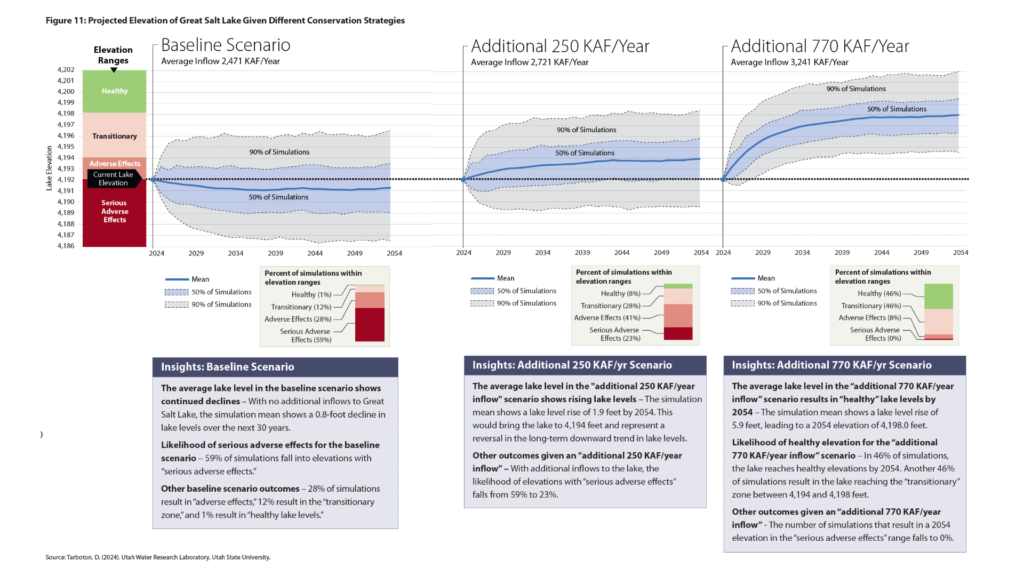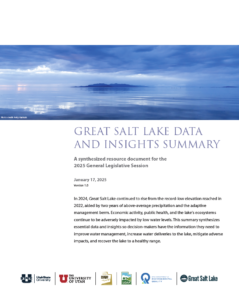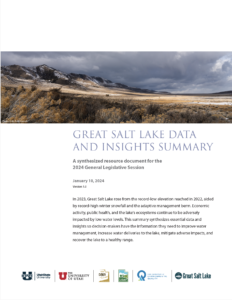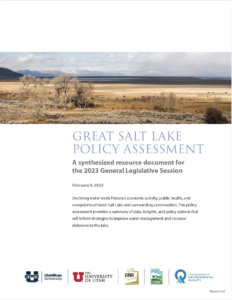The January 2025 Report
On January 14, 2025, the Great Salt Lake Strike Team — a collaboration of technical experts from Utah’s research universities and state agencies, which includes the Wilkes Center for Climate Science & Policy — released their 2025 data and insights summary. The authoritative analysis makes eminently clear four critical points:
- Benefits of the lake – Utah receives numerous economic, ecological, and human health benefits from the lake. The costs of inaction to the economy, human health, and ecological conditions remain significant.
- Making progress – Utah continues to make meaningful progress, including water conservation, infrastructure investment (including measurement and monitoring), statutory and regulatory reforms, berm management, and other actions. The state’s multi-year, data-driven strategy to conserve, dedicate, and deliver water to the lake is on track.
- Long-term endeavor – Stabilizing and raising lake levels, managing salinity, and protecting economic, human, and species health will require many years of stewardship leading up to the 2034 Olympic and Paralympic Winter Games and beyond. Success requires everyone in the Great Salt Lake Basin to participate in yearly conserving, dedicating, and delivering water to the lake.
- Utah’s plan – Later this month, the Office of the Great Salt Lake Commissioner’s Office will release the 2034 Plan for a Healthy Great Salt Lake. The plan builds upon the Great Salt Lake Strategic Plan, released in January 2024, by identifying actions needed over the next ten years to preserve the benefits Great Salt Lake provides to Utah and the world. Data developed by the Strike Team informs this plan.
About The Strike Team
The Great Salt Lake Strike Team includes researchers from the University of Utah and Utah State University working together with state leads from the Utah Department of Natural Resources and Utah Department of Agriculture and Food and additional experts from other entities. Together, these entities join in a model partnership to provide timely, relevant, and high-quality data and research that help decision-makers make informed decisions about Great Salt Lake.
The 2024 Policy Assessment Report
In January 2024, members of the Great Salt Lake Strike Team released a “Great Salt Lake Data and Insights Summary” to help decision-makers during the 2024 General Legislative Session. The report provides a summary of the 2023 water year and shares data and insights about reservoir storage, salinity, temperature, precipitation, streamflow and natural flow, runoff efficiency, human water use, mineral extraction, future water availability, and conservation planning.
The 2023 Policy Assessment Report
In fall of 2022, Utah’s public research universities – The University of Utah and Utah State University – formed the Great Salt Lake Strike Team to provide a primary point of contact for policymakers as they address the economic, health, and ecological challenges created by the record-low elevation of Great Salt Lake. Together with state agency professionals, the Strike Team brings together experts in public policy, hydrology, water management, climatology, and dust to provide impartial, data-informed, and solution-oriented support for Utah decision-makers. The Strike Team does not advocate but rather functions in a technical, policy-advisory role as a service to the state.
The Great Salt Lake Strike Team developed an evaluation scorecard to create apples-to-apples comparisons of the most often proposed options. By briefly outlining these policies and providing necessary context, options, and tradeoffs, we give an overview of expected water gains, monetary costs, environmental impacts, and feasibility. Many options work in conjunction with others, particularly “Commit Conserved Water to Great Salt Lake” which is foundational to shepherding water conserved through other policy options to the lake. The Great Salt Lake Strike Team released its first policy assessment report on February 8, 2023.
Recommendations
The Great Salt Lake Strike Team supports the data and research needs of state decision-makers. The Strike Team does not advocate for specific policy positions but does respond to requests to share technical expertise and evidence-based assessment.
The governor and Legislature have requested recommendations from the Strike Team to inform state actions in the near term. Consistent with this approach, the Strike Team offers six specific recommendations for gubernatorial and legislative support in the coming year.













